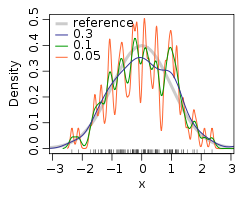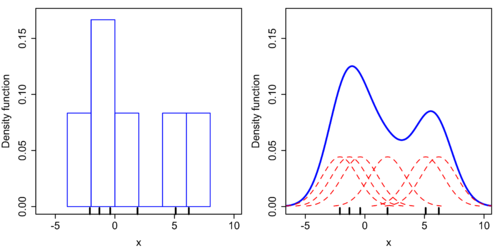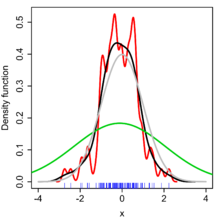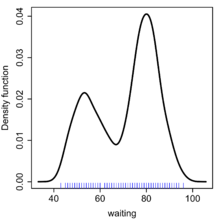- Kernel density estimation
-
 Kernel density estimation of 100 normally distributed random numbers using different smoothing bandwidths.
Kernel density estimation of 100 normally distributed random numbers using different smoothing bandwidths.
In statistics, kernel density estimation is a non-parametric way of estimating the probability density function of a random variable. Kernel density estimation is a fundamental data smoothing problem where inferences about the population are made, based on a finite data sample. In some fields such as signal processing and econometrics it is also known as the Parzen–Rosenblatt window method, after Emanuel Parzen and Murray Rosenblatt, who are usually credited with independently creating it in its current form.[1][2]
Contents
Definition
Let (x1, x2, …, xn) be an iid sample drawn from some distribution with an unknown density ƒ. We are interested in estimating the shape of this function ƒ. Its kernel density estimator is
where K(•) is the kernel — a symmetric but not necessarily positive function that integrates to one — and h > 0 is a smoothing parameter called the bandwidth. A kernel with subscript h is called the scaled kernel and defined as Kh(x) = 1/h K(x/h). Intuitively one wants to choose h as small as the data allows, however there is always a trade-off between the bias of the estimator and its variance; more on the choice of bandwidth later. A range of kernel functions are commonly used: uniform, triangular, biweight, triweight, Epanechnikov, normal, and others. The Epanechnikov kernel is optimal in a minimum variance sense,[3] though the loss of efficiency is small for the kernels listed previously,[4] and due to its convenient mathematical properties, the normal kernel is often used K(x) = ϕ(x), where ϕ is the standard normal density function.
Kernel density estimates are closely related to histograms, although the former have several advantages. We compare the construction of histogram and kernel density estimators, using these 6 data points: x1=-2.1, x2=-1.3, x3=-0.4, x4=1.9, x5=5.1, x6=6.2. For the histogram, first the horizontal axis is divided into sub-intervals or bins which cover the range of the data. In this case, we have 6 bins each of width 2. Whenever a data point falls inside this interval, we place a box of height 1/12. If more than one data point falls inside the same bin, we stack the boxes on top of each other. For the kernel density estimate, we place a normal kernel with variance 2.25 (indicated by the red dashed lines) on each of the data points xi. The kernels are summed to make the kernel density estimate (solid blue curve). The smoothness of the kernel density estimate is evident compared to the discreteness of the histogram. This discrete appearance is a result from the inherent statistical inefficiency of histograms as compared to kernel estimators.[5]
The construction of a kernel density estimate finds interpretations in fields outside of density estimation. For example, in thermodynamics, this is equivalent to amount of heat generated when heat kernels (the fundamental solution to the heat equation) are placed at the locations xi. Similar methods are used to construct Discrete Laplace operators on point clouds for manifold learning.
Relation to the characteristic function density estimator
Given the sample (x1, x2, …, xn), it is natural to estimate the characteristic function φ(t) = E[eitX] as
Knowing the characteristic function it is possible to find the corresponding probability density function through the inverse Fourier transform formula. One difficulty with applying this inversion formula is that it leads to a diverging integral since the estimate
 is unreliable for large t’s. In order to circumvent this problem the estimator
is unreliable for large t’s. In order to circumvent this problem the estimator  is multiplied by a damping function ψh(t) = ψ(ht), which is equal to 1 at the origin, and then falls to 0 at infinity. The “bandwidth parameter” h controls how fast we try to dampen the function
is multiplied by a damping function ψh(t) = ψ(ht), which is equal to 1 at the origin, and then falls to 0 at infinity. The “bandwidth parameter” h controls how fast we try to dampen the function  . In particular when h is small, then ψh(t) will be approximately one for a large range of t’s, which means that
. In particular when h is small, then ψh(t) will be approximately one for a large range of t’s, which means that  remains practically unaltered in the most important region of t’s.
remains practically unaltered in the most important region of t’s.The most common choice for function ψ is either the uniform function ψ(t) = 1{−1 ≤ t ≤ 1}, which effectively means truncating the interval of integration in the inversion formula to [−1/h, 1/h], or the gaussian function ψ(t) = e−π t2. Once the function ψ has been chosen, the inversion formula may be applied, and the density estimator will be
where K is the inverse Fourier transform of the damping function ψ. Thus the kernel density estimator coincides with the characteristic function density estimator.
Bandwidth selection
The bandwidth of the kernel is a free parameter which exhibits a strong influence on the resulting estimate. To illustrate its effect, we take a simulated random sample from the standard normal distribution (plotted at the blue spikes in the rug plot on the horizontal axis). The grey curve is the true density (a normal density with mean 0 and variance 1). In comparison, the red curve is undersmoothed since it contains too much spurious data artifacts arising from using a bandwidth h=0.05 which is too small. The green curve is oversmoothed since using the bandwidth h=2 obscures much of the underlying structure. The black curve is considered to be optimally smoothed since its density estimate is close to the true density.
The most common optimality criterion used to the select this parameter is the expected L2 risk function, also known as the mean integrated squared error
Under weak assumptions on ƒ and K,[1][2] MISE (h) = AMISE(h) + o(1/(nh) + h4) where o is the little o notation. The AMISE is the Asymptotic MISE which consists of the two leading terms
where
 for a function g,
for a function g,  and ƒ'' is the second derivative of ƒ. The minimum of this AMISE is the solution to this differential equation
and ƒ'' is the second derivative of ƒ. The minimum of this AMISE is the solution to this differential equationor
Neither the AMISE nor the hAMISE formulas are able to be used directly since they involve the unknown density function ƒ or its second derivative ƒ'', so a variety of automatic, data-based methods have been developed for selecting the bandwidth. Many review studies have been carried out to compare their efficacities,[6][7][8][9][10] with the general consensus that the plug-in selectors[11] and cross validation selectors[12][13][14] are the most useful over a wide range of data sets.
Substituting any bandwidth h which has the same asymptotic order n-1/5 as hAMISE into the AMISE gives that AMISE(h) = O(n-4/5), where O is the big o notation. It can be shown that, under weak assumptions, there cannot exist a non-parametric estimator that converges at a faster rate than the kernel estimator.[15] Note that the n−4/5 rate is slower than the typical n−1 convergence rate of parametric methods.
If the bandwidth is not held fixed, but is varied depending upon the location of either the estimate (balloon estimator) or the samples (pointwise estimator), this produces a particularly powerful method known as adaptive or variable bandwidth kernel density estimation.
Practical estimation of the bandwidth
If Gaussian basis functions are used to approximate univariate data, and the underlying density being estimated is Gaussian then it can be shown that the optimal choice for h is[16]
 , where
, where  is the standard deviation of the samples.
is the standard deviation of the samples.
This approximation is known as the normal distribution approximation (or Gaussian approximation).
Statistical implementation
A non-exhaustive list of software implementations of kernel density estimators includes:
- In C/C++, FIGTree is a library that can be used to compute kernel density estimates using normal kernels. MATLAB interface available.
- In CrimeStat, kernel density estimation is implemented using five different kernel functions - normal, uniform, quartic, negative exponential, and triangular. Both single- and dual-kernel density estimate routines are available. Kernel density estimation is also used in interpolating a Head Bang routine, in estimating a two-dimensional Journey-to-crime density function, and in estimating a three-dimensional Bayesian Journey-to-crime estimate.
- In ESRI products, kernel density mapping is managed out of the Spatial Analyst toolbox and uses the Epanechnikov kernel.
- In gnuplot, kernel density estimation is implemented by the
smooth kdensityoption, the datafile can contain a weight and bandwidth for each point, or the bandwidth can be set automatically.[17] - In Haskell, kernel density is implemented in the statistics package.
- In Java, the Weka (machine learning) package provides weka.estimators.KernelEstimator, among others.
- In Javascript, the visualization package D3 offers a KDE package in its science.stats package.
- In JMP, The Fit Y by X platform can be used to estimate univariate and bivariate kernel densitities.
- In MATLAB, kernel density estimation is implemented through the
ksdensityfunction (Statistics Toolbox). This function does not provide an automatic data-driven bandwidth but uses a rule of thumb, which is optimal only when the target density is normal. A free MATLAB software package which implements an automatic bandwidth selection method[18] is available from the MATLAB Central File Exchange for 1 dimensional data and for 2 dimensional data. - In Mathematica, numeric kernel density estimation is implemented by the function
SmoothKernelDistributionhere and symbolic estimation is implemented using the functionKernelMixtureDistributionhere both of which provide data-driven bandwidths. - In Octave, kernel density estimation is implemented by the
kernel_densityoption (econometrics package). - In Perl, an implementation can be found in the Statistics-KernelEstimation module
- In R, it is implemented through the
densityand thebkdefunction in the KernSmooth library (both included in the base distribution), thekdefunction in the ks library, thenpudensfunction in the np library (numeric and categorical data), thesm.densityfunction in the sm library. For an implementation of thekde.Rfunction, which does not require installing any packages or libraries, see kde.R. - In SAS,
proc kdecan be used to estimate univariate and bivariate kernel densities. - In SciPy,
scipy.stats.gaussian_kdecan be used to perform gaussian kernel density estimation in arbitrary dimensions, including bandwidth estimation. - In Stata, it is implemented through
kdensity; for examplehistogram x, kdensity. Alternatively a free Stata module KDENS is available from here allowing a user to estimate 1D or 2D density functions. - In Analytica release 4.4, the Smoothing option for PDF results uses KDE, and from expressions it is available via the built-in
Pdffunction. - In C++, libagf is a library for variable kernel density estimation.
Example in Matlab/octave
For this example, the data are a synthetic sample of 50 points drawn from the standard normal and 50 points from a normal distribution with mean 3.5 and variance 1. The automatic bandwidth selection and density estimation with normal kernels is carried out by kde.m. This function implements a novel automatic bandwidth selector that does not rely on the commonly used Gaussian plug-in rule of thumb heuristic.[18]
randn('seed',8192); x = [randn(50,1); randn(50,1)+3.5]; [h, fhat, xgrid] = kde(x, 401); figure; hold on; plot(xgrid, fhat, 'linewidth', 2, 'color', 'black'); plot(x, zeros(100,1), 'b+'); xlabel('x') ylabel('Density function') hold off;Example in R
This example is based on the Old Faithful Geyser, a tourist attraction located in Yellowstone National Park. This famous dataset containing 272 records consists of two variables, eruption duration (minutes) and waiting time until the next eruption (minutes), included in the base distribution of R. We analyse the waiting times, using the ks library since it has a wide range of visualisation options. The bandwidth function is
hpiwhich in turn calls thedpikfunction in theKernSmoothlibrary: these functions implement the plug-in selector.[11] The kernel density estimate using the normal kernel is computed usingkdewhich callsbkdefromKernSmooth. Theplotfunction allows the addition of the data points as a rug plot on the horizontal axis. The bimodal structure in the density estimate of the waiting times is clearly seen, in contrast to the rug plot where this structure is not apparent.library(ks) attach(faithful) h <- hpi(x=waiting) fhat <- kde(x=waiting, h=h) plot(fhat, drawpoints=TRUE)
See also
- Kernel (statistics)
- Kernel (mathematics)
- Kernel smoothing
- Kernel regression
- Mean-shift
- Scale space The triplets {(x, h, KDE with bandwidth h evaluated at x: all x, h>0} form a scale space representation of the data.
- Multivariate kernel density estimation
External links
- Introduction to kernel density estimation A short tutorial which motivates kernel density estimators as an improvement over histograms.
- Kernel Bandwidth Optimization A free online tool that instantly generates an optimized kernel density estimate of your data.
- Free Online Software (Calculator) computes the Kernel Density Estimation for any data series according to the following Kernels: Gaussian, Epanechnikov, Rectangular, Triangular, Biweight, Cosine, and Optcosine.
- Kernel Density Estimation Applet An online interactive example of kernel density estimation. Requires .NET 3.0 or later.
References
- ^ a b Rosenblatt, M. (1956). "Remarks on some nonparametric estimates of a density function". Annals of Mathematical Statistics 27: 832–837. doi:10.1214/aoms/1177728190.
- ^ a b Parzen, E. (1962). "On estimation of a probability density function and mode". Annals of Mathematical Statistics 33: 1065–1076. doi:10.1214/aoms/1177704472.
- ^ Epanechnikov, V.A. (1969). "Non-parametric estimation of a multivariate probability density". Theory of Probability and its Applications 14: 153–158. doi:10.1137/1114019.
- ^ Wand, M.P; Jones, M.C. (1995). Kernel Smoothing. London: Chapman & Hall/CRC. ISBN 0412552701.
- ^ Scott, D. (1979). "On optimal and data-based histograms". Biometrika 66: 605–610. doi:10.1093/biomet/66.3.605.
- ^ Park, B.U.; Marron, J.S. (1990). "Comparison of data-driven bandwidth selectors". Journal of the American Statistical Society 85 (409): 66–72. JSTOR 2289526.
- ^ Park, B.U.; Turlach, B.A. (1992). "Practical performance of several data driven bandwidth selectors (with discussion)". Computational Statistics 7: 251–270.
- ^ Cao, R.; Cuevas, A.; Manteiga, W. G. (1994). "A comparative study of several smoothing methods in density estimation". Computational Statistics and Data Analysis 17: 153–176. doi:10.1016/0167-9473(92)00066-Z.
- ^ Jones, M.C.; Marron, J.S.; Sheather, S. J. (1996). "A brief survey of bandwidth selection for density estimation". Journal of the American Statistical Association 91 (433): 401–407. doi:10.2307/2291420. JSTOR 2291420.
- ^ Sheather, S.J. (1992). "The performance of six popular bandwidth selection methods on some real data sets (with discussion)". Computational Statistics 7: 225–250, 271–281.
- ^ a b Sheather, S.J.; Jones, M.C. (1991). "A reliable data-based bandwidth selection method for kernel density estimation". Journal of the Royal Statistical Society. Series B 53 (3): 683–690. JSTOR 2345597.
- ^ Rudemo, M. (1982). "Empirical choice of histograms and kernel density estimators". Scandinavian Journal of Statistics 9 (2): 65–78. JSTOR 4615859.
- ^ Bowman, A.W. (1984). "An alternative method of cross-validation for the smoothing of density estimates". Biometrika 71: 353–360. doi:10.1093/biomet/71.2.353.
- ^ Hall, P.; Marron, J.S.; Park, B.U. (1992). "Smoothed cross-validation". Probability Theory and Related Fields 92: 1–20. doi:10.1007/BF01205233.
- ^ Wahba, G. (1975). "Optimal convergence properties of variable knot, kernel, and orthogonal series methods for density estimation". Annals of Statistics 3 (1): 15–29. doi:10.1214/aos/1176342997. http://projecteuclid.org/euclid.aos/1176342997.
- ^ Silverman, B.W. (1998). Density Estimation for Statistics and Data Analysis. London: Chapman & Hall/CRC. ISBN 0412246201.
- ^ Janert, Philipp K (2009). Gnuplot in action : understanding data with graphs. Connecticut, USA: Manning Publications. ISBN 978-1-933988-39-9. See section 13.2.2 entitled Kernel density estimates.
- ^ a b Botev, Z.I.; Grotowski, J.F.; Kroese, D.P. (2010). "Kernel density estimation via diffusion". Annals of Statistics 38 (5): 2916–2957. doi:10.1214/10-AOS799.
Categories:- Estimation of densities
- Non-parametric statistics
Wikimedia Foundation. 2010.











